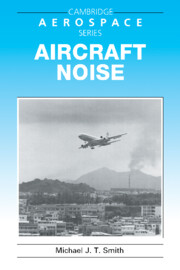Book contents
- Frontmatter
- Contents
- Preface
- Acknowledgments
- 1 Human reaction to aircraft noise
- 2 Action against aircraft noise
- 3 Aircraft noise sources
- 4 Power-plant noise control
- 5 Concorde – a special case
- 6 Noise data acquisition and presentation
- 7 Aircraft noise prediction
- 8 Prospects for the future
- 9 Review
- Appendices
- References
- Index
4 - Power-plant noise control
Published online by Cambridge University Press: 06 November 2009
- Frontmatter
- Contents
- Preface
- Acknowledgments
- 1 Human reaction to aircraft noise
- 2 Action against aircraft noise
- 3 Aircraft noise sources
- 4 Power-plant noise control
- 5 Concorde – a special case
- 6 Noise data acquisition and presentation
- 7 Aircraft noise prediction
- 8 Prospects for the future
- 9 Review
- Appendices
- References
- Index
Summary
Over the past thirty to forty years, a vast knowledge of aircraft noise-control techniques has been acquired. Some of the findings have contributed to the improved airport-noise climate of today; the less successful and the failures have taught both useful and bitter lessons. This chapter concentrates on success – success in the field of the jet engine, for it was this propulsion system that really started the serious noise problem.
For a broader understanding of the problem, the specific means of controlling aircraft power-plant noise should be discussed in relation to design philosophy, which, in turn, is related to either date of concept or aircraft mission requirements. The following sections deal with the range of power-plants in service in two convenient categories, low- and high-bypass-ratio types.
Suppression of the early jets
As explained in Chapter 3, it is the basic cycle and the maximum thrust level of the engine that determines the level of jet noise produced. The first generation of pure jets and, to a large extent, the low-bypass-ratio engines that succeeded them, all had extremely high exhaust velocities, which caused high levels of jet noise. At full power, supersonic exhaust flows with velocities of up to 600 m/sec were not uncommon and the characteristic crackling and tearing sounds of the mixing noise were augmented by the presence of shock-associated noise.
Without today's turbine cooling technology, there was no opportunity whatsoever to reduce the jet noise in these engines by modifying the engine cycle.
- Type
- Chapter
- Information
- Aircraft Noise , pp. 120 - 152Publisher: Cambridge University PressPrint publication year: 1989
- 5
- Cited by



